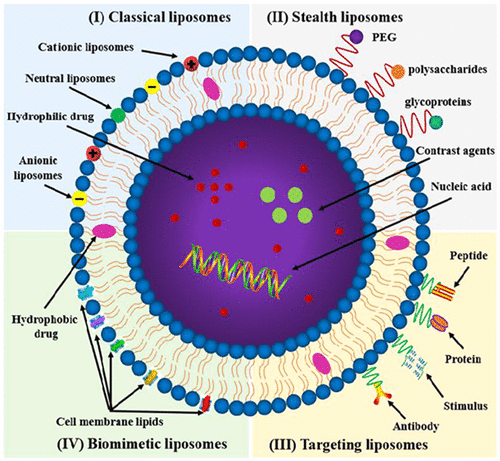当前位置:
X-MOL 学术
›
ACS Appl. Bio Mater.
›
论文详情
Our official English website, www.x-mol.net, welcomes your
feedback! (Note: you will need to create a separate account there.)
Recent Advancements in Liposome-Targeting Strategies for the Treatment of Gliomas: A Systematic Review
ACS Applied Bio Materials ( IF 4.6 ) Pub Date : 2020-08-14 , DOI: 10.1021/acsabm.0c00705 Jie Li 1, 2, 3, 4 , Tiantian Tan 1, 3, 4 , Liping Zhao 1, 3, 4 , Mengmeng Liu 1, 3, 4 , Yu You 2 , Yiying Zeng 1, 3, 4 , Dajing Chen 1, 3, 4 , Tian Xie 1, 2, 3, 4 , Lele Zhang 5 , Chaomei Fu 2 , Zhaowu Zeng 1, 3, 4
ACS Applied Bio Materials ( IF 4.6 ) Pub Date : 2020-08-14 , DOI: 10.1021/acsabm.0c00705 Jie Li 1, 2, 3, 4 , Tiantian Tan 1, 3, 4 , Liping Zhao 1, 3, 4 , Mengmeng Liu 1, 3, 4 , Yu You 2 , Yiying Zeng 1, 3, 4 , Dajing Chen 1, 3, 4 , Tian Xie 1, 2, 3, 4 , Lele Zhang 5 , Chaomei Fu 2 , Zhaowu Zeng 1, 3, 4
Affiliation

|
Malignant tumors represent some of the most intractable diseases that endanger human health. A glioma is a tumor of the central nervous system that is characterized by severe invasiveness, blurred boundaries between the tumor and surrounding normal tissue, difficult surgical removal, and high recurrence. Moreover, the blood–brain barrier (BBB) and multidrug resistance (MDR) are important factors that contribute to the lack of efficacy of chemotherapy in treating gliomas. A liposome is a biofilm-like drug delivery system with a unique phospholipid bilayer that exhibits high affinities with human tissues/organs (e.g., BBB). After more than five decades of development, classical and engineered liposomes consist of four distinct generations, each with different characteristics: (i) traditional liposomes, (ii) stealth liposomes, (iii) targeting liposomes, and (iv) biomimetic liposomes, which offer a promising approach to promote drugs across the BBB and to reverse MDR. Here, we review the history, preparatory methods, and physicochemical properties of liposomes. Furthermore, we discuss the mechanisms by which liposomes have assisted in the diagnosis and treatment of gliomas, including drug transport across the BBB, inhibition of efflux transporters, reversal of MDR, and induction of immune responses. Finally, we highlight ongoing and future clinical trials and applications toward further developing and testing the efficacies of liposomes in treating gliomas.
中文翻译:

用于治疗胶质瘤的脂质体靶向策略的最新进展:系统评价
恶性肿瘤代表了一些危害人类健康的最棘手的疾病。胶质瘤是一种中枢神经系统肿瘤,其特点是侵袭性严重、肿瘤与周围正常组织界限模糊、手术切除困难、复发率高。此外,血脑屏障(BBB)和多药耐药(MDR)是导致胶质瘤化疗疗效不佳的重要因素。脂质体是一种生物膜样药物递送系统,具有独特的磷脂双层,与人体组织/器官(例如,BBB)具有高亲和力。经过五年多的发展,经典和工程脂质体由四个不同的世代组成,每个世代都有不同的特征:(i)传统脂质体,(ii)隐形脂质体,(iii) 靶向脂质体,和 (iv) 仿生脂质体,这为促进药物通过 BBB 和逆转 MDR 提供了一种有前途的方法。在这里,我们回顾了脂质体的历史、制备方法和物理化学性质。此外,我们讨论了脂质体帮助诊断和治疗胶质瘤的机制,包括跨 BBB 的药物转运、外排转运蛋白的抑制、MDR 的逆转和免疫反应的诱导。最后,我们强调正在进行和未来的临床试验和应用,以进一步开发和测试脂质体在治疗神经胶质瘤中的功效。此外,我们讨论了脂质体帮助诊断和治疗胶质瘤的机制,包括跨 BBB 的药物转运、外排转运蛋白的抑制、MDR 的逆转和免疫反应的诱导。最后,我们强调正在进行和未来的临床试验和应用,以进一步开发和测试脂质体在治疗神经胶质瘤中的功效。此外,我们讨论了脂质体帮助诊断和治疗胶质瘤的机制,包括跨 BBB 的药物转运、外排转运蛋白的抑制、MDR 的逆转和免疫反应的诱导。最后,我们强调正在进行和未来的临床试验和应用,以进一步开发和测试脂质体在治疗神经胶质瘤中的功效。
更新日期:2020-09-21
中文翻译:

用于治疗胶质瘤的脂质体靶向策略的最新进展:系统评价
恶性肿瘤代表了一些危害人类健康的最棘手的疾病。胶质瘤是一种中枢神经系统肿瘤,其特点是侵袭性严重、肿瘤与周围正常组织界限模糊、手术切除困难、复发率高。此外,血脑屏障(BBB)和多药耐药(MDR)是导致胶质瘤化疗疗效不佳的重要因素。脂质体是一种生物膜样药物递送系统,具有独特的磷脂双层,与人体组织/器官(例如,BBB)具有高亲和力。经过五年多的发展,经典和工程脂质体由四个不同的世代组成,每个世代都有不同的特征:(i)传统脂质体,(ii)隐形脂质体,(iii) 靶向脂质体,和 (iv) 仿生脂质体,这为促进药物通过 BBB 和逆转 MDR 提供了一种有前途的方法。在这里,我们回顾了脂质体的历史、制备方法和物理化学性质。此外,我们讨论了脂质体帮助诊断和治疗胶质瘤的机制,包括跨 BBB 的药物转运、外排转运蛋白的抑制、MDR 的逆转和免疫反应的诱导。最后,我们强调正在进行和未来的临床试验和应用,以进一步开发和测试脂质体在治疗神经胶质瘤中的功效。此外,我们讨论了脂质体帮助诊断和治疗胶质瘤的机制,包括跨 BBB 的药物转运、外排转运蛋白的抑制、MDR 的逆转和免疫反应的诱导。最后,我们强调正在进行和未来的临床试验和应用,以进一步开发和测试脂质体在治疗神经胶质瘤中的功效。此外,我们讨论了脂质体帮助诊断和治疗胶质瘤的机制,包括跨 BBB 的药物转运、外排转运蛋白的抑制、MDR 的逆转和免疫反应的诱导。最后,我们强调正在进行和未来的临床试验和应用,以进一步开发和测试脂质体在治疗神经胶质瘤中的功效。











































 京公网安备 11010802027423号
京公网安备 11010802027423号